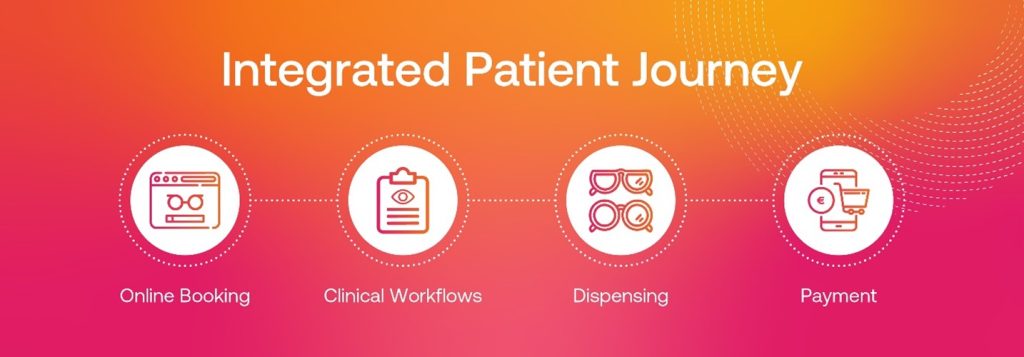Patients expect seamless, efficient, and personalised experiences at every stage of the eyecare journey, from initial appointment booking right through to purchasing eyewear. Gone are the days of relying on separate systems and manual processes. Optical practices that streamline operations not only enhance patient satisfaction but also see significant improvements in practice efficiency and profitability. A digital patient journey, supported by an integrated approach and the right technology such as optician practice management software, ensures a cohesive, smooth experience for patients, whether they engage online or in-person.
Having spent 20+ years as a dispensing optician and more recently as a professional services consultant at Ocuco, I’ve witnessed firsthand the growing shift in patient expectations, largely driven by advances in technology and digitisation.
Practices that leverage streamlined processes and integrated technologies are uniquely positioned to not only meet these expectations but also enhance patient retention. In my experience, practices that embrace these changes create lasting, positive impressions on their patients while simultaneously improving internal efficiency.
Enhancing Patient Experience with Online Booking
Booking an eye exam online is often the first touchpoint of the eyecare journey and can set the tone for the entire experience. When I began my career as a dispensing optician, every appointment was booked over the phone or in person and manually added to the practice diary.
If a patient required any changes to their appointment or needed to cancel, they had to phone the practice, often resulting in staff time being taken up handling last-minute adjustments and unfilled appointment slots. However, now integrated online booking systems allow patients to book appointments 24/7, view available time slots, and even reschedule or cancel appointments without the need for direct staff involvement.
At Ocuco we’ve seen practices that have implemented Acuitas 3’s integrated diary, increase their appointment bookings by up to 30% while also benefiting from noticeable reductions in no-shows, all with minimal staff intervention. Staff members are freed up to focus on more critical tasks, leading to a more streamlined and efficient operation overall to the benefit of both staff and patients.
The benefits of an integrated booking approach go beyond the booking process itself. It allows patients to input preliminary details, upload insurance information, and specify any concerns or special requests before stepping into your practice.
This proactive approach not only saves time but also equips the practice with relevant information to tailor the consultation, ensuring a more personalised and effective eyecare experience. From the front desk to the examining optometrist and dispensing optician, having this information centralised ensures everyone is on the same page, for a smooth patient flow throughout the practice.
Click here to learn more about the Hidden Costs of Poor Scheduling in Optical Practices.
Real-Time Patient Data and Seamless Clinical Workflows
When a patient arrives, an integrated practice management software streamlines patient flow by centralising key information, so everything from medical history to appointment details and preferences is easily accessible. This enables seamless transitions throughout the visit.
During the eye exam, an integrated workflow eliminates delays from manual processes and missing data. Optometrists can quickly retrieve updated records, review previous consultations, and prescribe with precision ensuring continuity throughout the eye exam. There is no longer a need for handwritten handover notes and briefings as it is all accessible within the patient’s record within a few clicks.
This accessibility of data within the practice is a game-changer for the likes of dispensing opticians who no longer need to rely on in-depth post-eye exam briefings from optometrists, knowing that all the information is recorded if a handover cannot take place or the dispense is completed at a later date.
By reducing administrative tasks, the focus remains on providing uninterrupted, personalised care, ensuring a smooth and stress-free experience for the patient.
Dispensing and Payment Integration: A Seamless Conclusion to the Journey
After the eye exam, the next step in the digital patient journey is eyewear selection and payment. With integrated practice management software for opticians, these tasks become more efficient for a smooth patient flow. The ability to track inventory in real-time ensures the selected eyewear is available and in stock, with automatic reordering helping to maintain optimum stock levels especially for core ranges.
This was a benefit I saw firsthand as an Acuitas 2 user when I worked in practice, as the optical inventory management software ensured patients had a wide variety of frames to choose from. As a dispensing optician this also enabled me to spend more time with patients and less time focusing on the admin side of stock management.
Acuitas 3 now takes this even further, offering advanced features for automated product reordering and inventory management. It’s even possible to see what frames patients have browsed online pre-appointment so that you can have them ready for them to try on and fit post-eye exam for a truly integrated experience. The optical inventory software ensures stock levels are consistently maintained, minimizing the risk of both shortages and overstocking.
From a patient perspective, this means the products they want are always available. For the practice, it eliminates discrepancies in stock levels, as well as the need for manual inventory management and reordering. From a revenue standpoint, it helps maintain optimal stock levels by ensuring you only carry frames and products from popular, high-demand ranges. This is functionality that has been particularly beneficial to multi-location users of Acuitas 3 looking to centralise stock management throughout several practices.
The payment experience should be equally seamless in order to maintain a streamlined patient flow. Once the patient has selected their eyewear, an integrated system automatically processes payments and insurance claims, reducing administrative work and accelerating cash flow. Integrated payment solutions like OcuPay integrate directly with Acuitas 3, eliminating errors and the need for manual entry, as your credit card terminal and point-of-sale system are aligned, removing the need for manual end of day-reconciling, a task that nobody looks forward to when working in-practice.

The Benefits of an Integrated Approach
An integrated experience that combines online booking, patient records, clinical workflows, and payment processing offers numerous benefits for both patients and practices:
1. Improved Patient Satisfaction
By offering online booking, seamless check-ins, and easy access to billing information, you provide a better experience that meets patient’s needs. This not only leads to higher patient satisfaction but also builds loyalty, making it more likely that they will return for future visits and recommend your optical practice to others.
2. Increased Efficiency and Reduced Errors
With an integrated web based optometry software, data is automatically updated across all touchpoints. This reduces the chances of errors that typically arise when patient information has to be manually entered or transferred between different systems. By automating routine tasks such as appointment scheduling, patient record updates, and payment processing, practices can operate more efficiently and focus on providing quality care.
3. Cost Savings
Reducing manual data entry, administrative overhead, and no-show rates leads to cost savings for the practice. An integrated digital patient journey also improves inventory management, allowing practices to reduce stockouts or overstocking, which helps lower costs.
4. Streamlined Workflow for Staff
With a cohesive optician management software, practice staff can access everything they need in one place. From booking appointments to dispensing eyewear and processing payments, everything is connected, reducing the need for staff to juggle multiple systems. This boosts productivity, reduces stress, and ensures smoother day-to-day operations.
5. Faster Payment Processing
With integrated payment solutions, practices can speed up the payment process, reduce billing errors, and enhance cash flow. Patients can pay securely online or in person and staff can quickly generate accurate invoices without needing to manually input payment data.
Conclusion: Inclusive Patient Care Through Technology
From online booking to seamless clinical workflows and automated inventory management, adopting an integrated approach ensures that both patients and practices benefit from a more streamlined, efficient experience.
In my years as both a dispensing optician and a professional services consultant, I’ve seen firsthand how integrated technologies can transform not only how practices operate but also the eyecare journey for their patients. Practices that embrace these advancements stand to improve patient satisfaction, enhance operational efficiency, and drive patient retention, while differentiating themselves in an increasingly competitive market.
By adopting an integrated, tech-enabled approach, you’re not just keeping up with the future of eyecare; you’re actively shaping it, delivering a smoother, more personalised experience for your patients and ensuring your practice runs at its highest potential.




